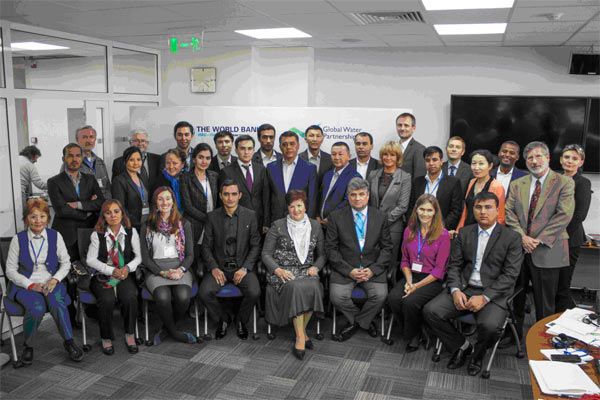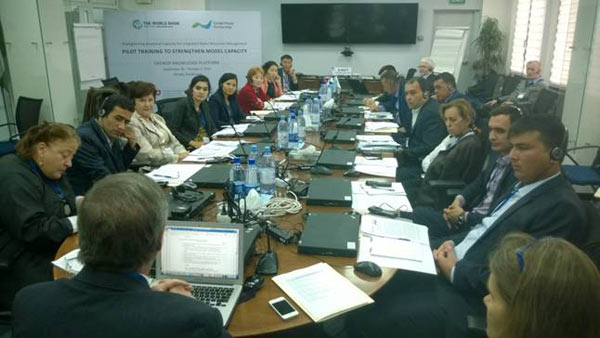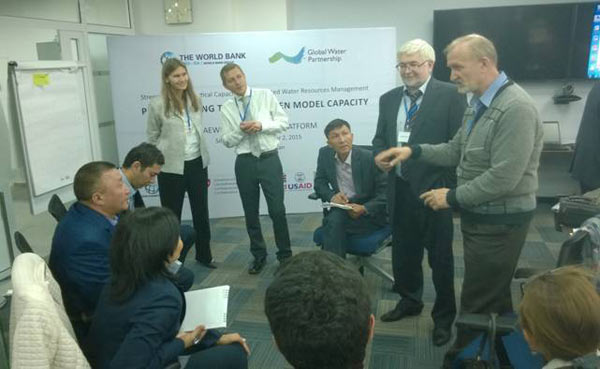PILOT TRAINING “STRENGTHENING MODEL CAPACITY”
Analysis on integrated water resources management carried out by the World Bank in 2013 revealed low capacity in computer modeling across all five countries of Central Asia, and Afghanistan. Special training courses on application of computer models in the region were initiated within the framework of Central Asia Energy-Water Development Program (CAEWDP).
The work began with the establishment of Model Advisory group, which organized a three-day videoconference for the specialists from all Central Asia countries in Tashkent on October 15-17, 2014. This conference facilitated interactive discussions of model use aspects and initiated joint activity of the World Bank and GWP CACENA “Strengthening model capacity”.
The aim of these activities is to ensure understanding of modeling tool concepts and capabilities by specialists from Central Asia who are responsible for decision making at the middle and high level of water management.
The Model Advisory Group (established in 2014) chose three of eight models put into practice in Central Asia so that the specialists could analyze and compare various analytical approaches. These models are AralDIF (Aral Sea Basin Dynamic Information Framework that can be adapted to Aral Sea basin conditions), ASBmm (Aral Sea Basin Management Model – basin simulation-optimization model of water allocation with calibrated information for planning zones) and BEAM (Aral Sea Basin Economic Allocation Model emphasizing economic investment analysis in the basin).
Pilot training was held at the World Bank premises in Almaty, Kazakhstan from September 28, 2015 to October 2, 2015. The task of the pilot training is to test the curriculum and other features of the proposed training program by the participants, i.e. to test the acceptability of course for model tools use (in terms of three models) but not getting “under the hood” too much.
Mid-level experts from the Central Asia countries and Afghanistan (two from each country), as well as representatives of EC-IFAS, BWO Amudarya and BWO Syrdarya and RCH who have little experience in modeling were invited to pilot training. Unfortunately, representatives of Turkmenistan did not participate in the pilot training.

Participants of the pilot modeling training in Almaty, September 29, 2015
The program of the seminar lasted for five working days. On the first working day participants got acquainted with each other and considered main concepts of water cycle/balance. Hydrology specification in the Aral Sea basin as well as water related issues in terms of reconciliation of hydro energy and agriculture were considered.
Furthermore, background information about river basins modeling, modeling objectives, water use by competing sectors and integrated water resources management issues (IWRM) was provided on the first day of the seminar. Various models and approaches were discussed.
IWRM is a process that enables coordinated development and management of water, land and other related resources to achieve high socioeconomic growth on an equitable basement without causing damage to stability of vital ecosystems. To ensure IWRM it is important to take note of different social, economic and environmental aspects related to resource use and protection. Coordinated management of water and other resources may demand to make decisions on a range of space-and-time scales - where modeling can assist.
In the afternoon of the first day the participants were given brief information about each of the three models (AralDIF, BEAM and ASBmm), their capabilities and the interconnectedness of them in terms of hydrology, economy and planning zones management. The purpose of this discussion was to understand the capabilities of the available models to solve different problems. Model assumptions and limitations were discussed. A brief presentation was made of objective functions (hydropower, agricultural production, municipal water use benefits), constraints and a few other details: simulation vs. optimization, economics, crop production functions, etc.

Working moments of the seminar
Participants discussed pre-defined sample problems (for solution of which three models were developed) with sample exercises for each model, including water cycle samples, planning and management options.
The second day of the seminar used the BEAM model to demonstrate the development and use of an economic basin allocation model to improve the understanding of water allocation options in river basins. The participants gain an understanding of the BEAM model structure, assumptions, and possible applications.
Participants discussed a scenario to demonstrate BEAM model capabilities. Group exercises considered a scenario in BEAM in detail taking into account approved limitations, basin hydrological structure, water sources, water intakes, time horizon and intervals. Data necessary for modeling of the pre-defined sample problems were discussed and analyzed in details. The basic BEAM mechanisms, including constitutive equations, optimization and other features were discussed.
The separate session was dedicated to consideration of BEAM calibration options in solving pre-defined sample problems and to sensitivity analysis. Indicators and quantitative aspects of model effectiveness and of alternative options were also discussed. Participants considered how the model could be used to assess effectiveness of solutions for pre-defined sample problems.
In this session participants had an opportunity to work with BEAM in a hands-on environment. Using some pre-computed results for the problem(s) and model(s), the group determined if the models were well calibrated or not.
On the third day of the seminar participants discussed modeling in ASBmm. ASBmm demonstrated the development and use of a basin allocation simulation model to improve the understanding of water management allocation options in the river basins. The participants gained an understanding of the ASBmm model structure, assumptions, and possible applications.

Seminar coordinators: Anatoliy Sorokin (SIC ICWC), Daryl Fields (WB),
Vadim Sokolov (GWP CACENA)

Yuriy Ukhalin (SIC ICWC) speaks about specifications of ASBmm model
Participants discussed a scenario to demonstrate ASBmm model capabilities. Participants reviewed in details the sample problem in ASBmm model, taking into account boundaries, flow network, water sources, water flows, time horizon and intervals. Necessary assumptions and related limitations in model use were discussed. Participant discussed data necessary for pre-defined sample problem modeling at the basin level and in separate planning zones. The basic ASBmm mechanisms, including basic constitutive equations, optimization and other features were discussed. In this session participants had an opportunity to work with ASBmm in a hands-on environment in the Syrdarya River basin and Fergana planning zone.
Unfortunately, on that day we lost our dearest colleague Mr.Yuriy Ukhalin who died suddenly of a heart attack during practical sessions on ASBmm.
The fourth day of the seminar was dedicated to modeling in AralDIF. AralDIF model demonstrated development and use of a hydrology model platform to improve the understanding of water availability options in the river basins. The participants gained an understanding of the ASBmm model structure, assumptions, and possible applications.
Participants discussed a scenario to demonstrate AralDIF model capabilities. Necessary assumptions and related limitations in model use were discussed.
Data necessary for scenario modeling were considered and analyzed. The importance of model calibration was discussed during practical exercises. Model output was compared with actual recorded data to determine exact model parameters. In this session participants had an opportunity to work with AralDIF in a hands-on environment.
The fifth – the last day of the seminar participants discussed how three models complement each other and help find solutions to water resources management in Central Asia. Participants had an opportunity to prepare their own remarks for discussions beforehand. On the third day of training the participants were asked to answer the following questions:
- What problems/tasks occur in model use and how to solve them?
- What information missed during the course?
- What is the future vision?
There also discussed issues how to work with those who are responsible for decision making and policymaking process: how to fortify confidence and keep responsible persons informed to facilitate them to make reasonable decisions.
The seminar was followed by the working meeting of the Coordinating Group (Daryl, Dane, Marta, Bekele, Sasha Ricci, Michel and Vadim) which was held on October 3. The participants agreed upon further steps on joint activity promotion of the World Bank and GWP CACENA «Strengthening model capacity».
Detailed report on pilot training held in Almaty will be provided by Dane McKinney for further distribution by December 1. What is important is that we got a better understanding about three models capabilities and how to organize training on their basis. We now better understand who and how should be trained to use model tools.
The final version of the training courses will also be submitted by this date. At the same time separate training course on each model will be considered:
- Separately consider BEAM and ASBmm used for prospective economic and mathematical modeling with their imitations and optimizations.
- Separately consider models for water resources and potential flow fluctuations assessment using AralDIF platform.
- It makes sense to consider cooperation with FAO and ICARDA in training on model tools for water consumption assessment – taking into account soil structure change, climate change, and irrigated agriculture productivity assessment change within the framework of food security and so on.
- Maybe a combined approach for model demonstrations should be accepted– step by step/in chain order – firstly, water resources assessment (AralDIF) – then calculation of development options based on this assessment (BEAM and ASBmm). Thus, to demonstrate that models do not compete but complement each other.
The group also considered training process institutionalization issues, i.e. its organization and coordination and management. These matters should be solved before the launching of a new, big, regional project by the World Bank (CAWARM). After launching, this project can support this organizational platform.
In cooperation with concerned Water Management Departments it is of great importance to determine and appoint focal points. They should meet the following two requirements:
1) To have technical knowledge and be aware of model use, and
2) To be able to lobby on this issue at the political level.
To sum up the results of the training, it can be said that 3 persons as focal points can be already appointed – Sayed Razekhudin in Afghanistan, Saule Shalmaganbetova in the Republic of Kazakhstan and Yekaterina Sakhvaeva in Kyrgyz Republic. It is of great importance to appoint the persons of the same level in the Republic of Tajikistan and the Republic of Uzbekistan as the representatives of these countries do not fully meet the above mentioned requirements. It is important to involve Turkmenistan into this process.
The participants also discussed how to arrange exchange of information and documents within the framework of the Coordinating group. One can use Dropbox but not everyone can work with this tool. Alternatively GWP CACENA will discuss with Stockholm how to create a special page like “See in One” or Share Point at GWP web-site. There will be provided current information for training “Strengthening model capacity” held within the framework of joint work with the World Bank and GWP CACENA. It is necessary to prepare Press Release or Policy note (Dane, Martha and Vadim can prepare till the end of October) based on available materials and results of pilot training to raise awareness of a wider range of people about this activity in the region.
Participants also discussed whom the course should be orientated for and the curriculum. Two types of courses may be organized:
1. General courses without detailed study of models for the representatives of academic and research institutes, concerned Ministries and Departments.
2. Special courses with detailed study of models for the specialists of Water Management Organizations including Basin Organizations.
The next exchange of views of the Coordinating Group will be organized on October 16 via Skype.
|